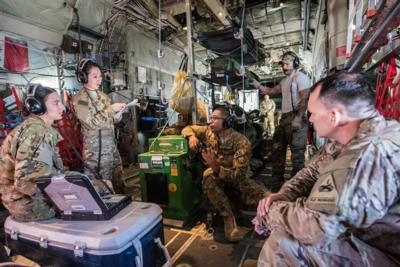Carrying Injured Service Members From The Battlefield 'All The Way Home'
The morning starts early with an alert about four hours before takeoff. Members of the 379th Expeditionary Aeromedical Evacuation Squadron begin several mandatory tasks before boarding the aircraft. Nurses go over mission details, as medical technicians pack more than a thousand pounds of equipment on a flatbed that is ready to load onto the plane. They must take all their usual gear including bandages, intravenous fluid, regulators, defibrillators, suction units and various other pieces of medical equipment. They take these supplies partially as a precaution, as they don’t know what they may need to keep patients stable in the air above the Middle East.

These teams, the aircrew and aircraft are flying ambulances for the U.S. Central Command area of responsibility.
The 379th EAES deployed to Al Udeid Air Base, Qatar, is one of the only two aeromedical evacuation squadrons in the AOR available to pull wounded warriors off of the battlefield and make sure they get the care they need. According to Lt. Col. Julia Moretti, 379th EAES commander, their job is to transport wounded warriors to a higher echelon of care. “We take them from the battlefield all the way home,” Moretti said.
If military personnel get injured or sick in the battlefield, the wounded initially receive first aid buddy care. If life-saving surgery is needed, the patients are flown to the nearest hospital abroad. That is where 379th EAES comes in. They bring the injured service member back to Al Udeid AB. If they require more intensive care, they will then be transported to Landstuhl Regional Medical Center, Germany, and if they can’t be fully treated overseas, they will return to the U.S. “The goal is to keep them at the lowest level of care, rehab them and then get them back into the fight quickly as possible,” said Senior Master Sgt. Matthew Ausfeld, 379th EAES first sergeant.
In addition to the AE teams, the squadron also has Critical Care Air Transport Teams, which are specialized medical teams comprised of one doctor, an intensive care nurse, and a respiratory therapist. If AE teams are the flying ambulance, CCATT is the ICU. If patients can be treated and return to work while deployed, they will stay in the AOR. However, if they have a more severe condition and can’t physically manage doing office work as they recover, they will return home.
As the war has progressed, the severity, type and amount of injuries have decreased significantly. In the early 2000s, the teams would care for 20-30 patients that would require transporting on a litter. “Now that is the exception, and we’re glad to see we aren’t having that many now,” Moretti said.
Aeromedical evacuation teams are made up of two nurses and three medical technicians. All members of AE are considered flight crew and, on top of all the medical expertise they must know and practice, they also need to know all about the aircraft they are flying on. They have to know how to put together seats, install stanchions to hold patient litters and how the electricity works for their machines aboard the aircraft, among many other details.
AE teams are also required to have the knowledge to perform their duties on a wide variety of aircraft, such as the KC-135 Stratotanker, C-130 Hercules, C-17 Globemaster III, C-5 Galaxy, and C-21. The AE teams here exemplify total force integration in that active duty, Reserve, and Air National Guard members combine to create the medical teams. In fact, only a small percentage of the teams are made up of active duty Airmen. “The Guard and Reserve components are a key part in the Aeromedical Evacuation world,” Moretti said. “Around 88 percent of AE is Guard and Reserve augmenting active duty. It’s a team effort with all the components to transport and care for our Wounded Warriors.”
According to Moretti and Ausfeld, the job of an AE Airman is a rewarding one. “It’s a great feeling helping our wounded warriors,” Moretti said. “Taking care of our own that were injured or became sick while protecting us, it’s a small way to give back. We pamper the patients and give them the best tender loving care we can.”
“I've moved wounded warriors around the world, some with severe battle injuries,” Ausfeld said. “They'll look you in the eyes and thank you for what you're doing for them. It can catch you off guard and it can be hard to respond to. Because these warriors, these sons, daughters, mothers, fathers, brothers and sisters, have sacrificed their body and soul. We're just making sure they get home.”
(Image provided with USAF news release)
 ANN's Daily Aero-Linx (04.15.24)
ANN's Daily Aero-Linx (04.15.24) Classic Aero-TV: 'No Other Options' -- The Israeli Air Force's Danny Shapira
Classic Aero-TV: 'No Other Options' -- The Israeli Air Force's Danny Shapira Aero-News: Quote of the Day (04.15.24)
Aero-News: Quote of the Day (04.15.24) Airborne 04.16.24: RV Update, Affordable Flying Expo, Diamond Lil
Airborne 04.16.24: RV Update, Affordable Flying Expo, Diamond Lil ANN's Daily Aero-Term (04.16.24): Chart Supplement US
ANN's Daily Aero-Term (04.16.24): Chart Supplement US



